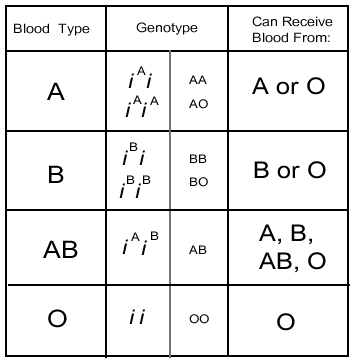What are the Common Blood Types?
There are 8 blood types: O Positive, O Negative, A Positive, A Negative, B Positive, B Negative, AB Positive and AB Negative.
Type A people have the A antigen on their red cells
Type B people have B antigen on their red cells
Type AB people have A and B antigen on their red cells
Type O people have neither antigen on their red cells
The positive and negative titles represent the presence or absence of the RH-factor.
Blood types are genetic and each person receives one copy of their blood type gene from each parent. A and B are always dominant over O. A and B are codominant when both are present. Therefore if someone inherits an A gene from one parent and a (blank) O from the other, he will be type A. However if he inherits an A gene from one parent and a B gene from the other, he will be type AB.
Because blood types are hereditary, they can be used to exclude (but not include) someone as father in cases of paternity. If two parents are blood type O, they can only produce children who are also type O. If just one parent is AB, the child will be either A,B or AB--it would be impossible for the child to be type O.
When we do a blood type, we type the red blood cells with Anti-A, Anti-B and Anti-D (RH). Agglutination with these anti-sera indicates the presence of the appropriate antigen. For example, if there is agglutination when red cells are mixed with Anti-A antisera, but none when these same red cells are combined with Anti-B and Anti-D this means that the patient is type A Negative. We call the typing of the red cells in this way the "forward" or "front" type.
People create naturally occurring antibodies to foreign blood types around 6 months of age.
Type A people naturally form Anti-B.
Type B people naturally form Anti-A.
Type O people naturally form Anti-A and Anti-B, actually Anti-A,B
We also do what's called a "reverse" or "back" type. As a confirmatory measure, we take a couple drops of patient plasma and test them against known A and B cells. If a person is type B, his plasma should agglutinate known A cells (due to his natural Anti-A), but not the B cells.
The presence of these naturally occurring ABO antibodies is the reason why everyone can't receive blood from any random person. A person transfused with blood of an incompatible type would have a severe hemolytic transfusion reaction could die within moments.
Here is a compatibility chart illustrating which blood types can donate and accept from others.
As you can see Type O Negative is the universal donor and can donate to anyone and Type AB Pos is the universal acceptor and can receive blood from any type.
Only blood bankers and some nurses/doctors would know that this chart isn't completely accurate. Although we try to give RH-negative patients only RH-negative blood, sometimes we do not in the interest of our blood inventory. Therefore sometimes an O-negative patient will receive several units of O-Positive red cells. The only time we would absolutely not do this is when it is known that the patient has Anti-D (an antibody to the RH factor) and we try not to do this with RH-negative women of childbearing age because we do not want to stimulate them to develop Anti-D which could later affect any RH positive children they may carry.



Thank you for posting. This blog had great information on blood donation. Bloodsource.org is a great company in Sacramento that I affiliate with.
ReplyDelete